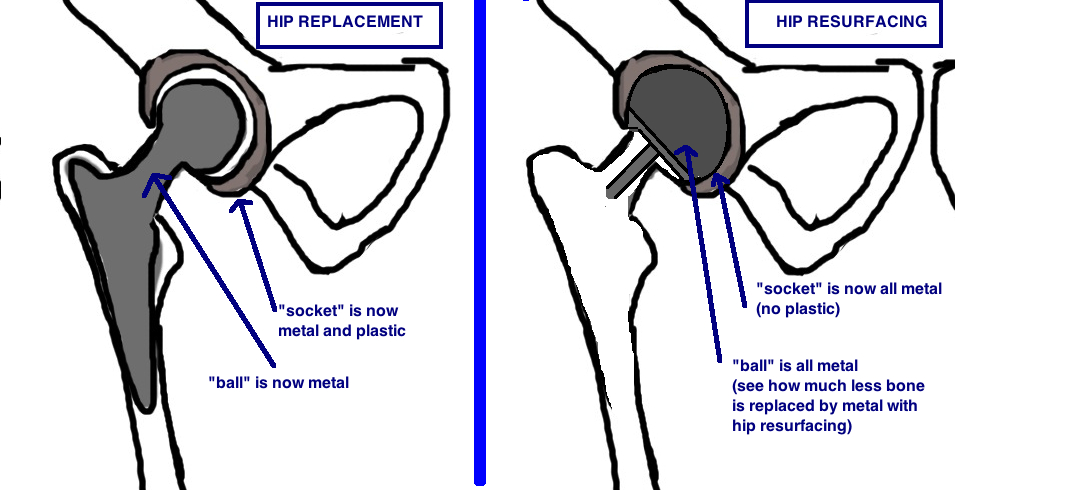Arthritis is a condition that can affect any joint in our body, and it occurs when the cartilage wears out.
Cartilage lines the ends of our bones, and makes them very smooth, so that when they glide against each other at our knee joint, or hip joint, or shoulder joint, there is very little friction. When cartilage wears out, the bones are not smooth any more, and so the amount of friction goes up and up, and this causes inflammation and this causes pain, and that is arthritis.
There are different treatments for arthritis, including taking oral anti-inflammatories (NSAIDS) or getting steroid injections which also decreases inflammation within the joint. However, once the cartilage is completely worn out, the inflammation becomes so bad that medication cannot prevent pain. This is the time when people see orthopedic surgeons to look for other treatments for arthritis.
For hip arthritis (see talk), the most common surgical treatment is a hip replacement. A total hip replacement is a very successful surgery. It removes the bone around your hip joint, and replaces it with metal and very thick plastic, which creates a very low friction environment and the inflammation goes away and so does the pain. The only problem with hip replacements, is that they last between 20 to 30 years in a best case scenario. In people that are 70 or 80 years old, this is usually ok because by the time their hip replacement as worn out their are either not walking any more because of advanced age, or they have passed away. However, there is a small group of people that develop arthritis when they are very young. In this group, the concern is that the hip replacement will wear out while they are still very active. Its not uncommon go get a second surgery to replace an old hip replacement, however, there are extra complications with this second surgery.
A different surgery was developed as an alternative to a hip replacement, called a "Hip Resurfacing". It is very similar to a hip replacement because the end of the bone is lined with metal to reduce friction and inflammation, however a Hip Resurfacing only removes a very small amount of the femur (the ball part of the ball and socket joint), while a hip replacement removes all of the bone that makes up the ball part of the hip joint and replaces it with metal.
It is believed that the advantage to a hip resurfacing is that less bone is taken and therefore, it feels more like a normal hip. The other advantage is that if the hip resurfacing wears out, there is still a lot of healthy bone around the implant, and therefore a second surgery will be easier than a second surgery for a total hip replacement.
However, there is one big issue with the hip resurfacing procedure that has made it very unpopular recently. The hip resurfacing implant is a "Metal on Metal" contact between the ball and socket. In contrast, the hip replacement implant is a "metal on plastic" contact between the ball and socket. This is important because the over time, all implants start to wear out and debris is released into the body. With a hip replacement, small pieces of plastic are released into the body and this causes a small reaction from the body. Yet with a hip resurfacing procedure, the metal debris is released into the body and this causes a much bigger reaction from the body in a lot of people. The metal debris causes such a big reaction in about 10-20% of people that it requires the implant to be removed within 15 years. Therefore, many orthopedic surgeons believe that this metal debris counteracts any benefits to the hip resurfacing and they only want to perform hip replacements in patients.
REFERENCES
1. Bisschop, Boomsma MF et al. High prevalence of pseudotumors in patients with a Birmingham Hip Resurfacing prosthesis: a prospective cohort study of one hundred and twenty-nine patients. JBJS 2013. see full article.
2. Canadian Hip Resurfacing Study Group. J Bone Joint Surg Am. 2011 May;93 Suppl 2:118-21. A survey on the prevalence of pseudotumors with metal-on-metal hip resurfacing in Canadian academic centers. this study reports the rate of pseduotumors in Hip resurfacing is very low (0.10%) vs. THA for MoM (1%).
3. Marshall DA et al. Hip resurfacing versus total hip arthroplasty: a systematic review comparing standardized outcomes. CORR 2014. full article.
4. Haughom BD et al. Do Complication Rates Differ by Gender After Metal-on-metal Hip Resurfacing Arthroplasty? A Systematic Review. CORR 2015. full article.
5. Oak SR et al. Mid-Term Results and Predictors of Patient-Reported Outcomes of Birmingham Hip Resurfacing. J Arthroplasty. 2016. full article.
6. Matharu GS et al. Poor Survivorship and Frequent Complications at a Median of 10 Years After Metal-on-Metal Hip Resurfacing Revision. CORR 2016. full article.
7. Pascual-Garrido C, Morris BL, Dayton MR. Clinical and Functional Outcomes of the Birmingham Hip Resurfacing System. Orthopedics. 2016 Mar-Apr;39(2)
8. Matharu GS et al. Prevalence of and Risk Factors for Hip Resurfacing Revision A Cohort Study Into the Second Decade After the Operation. JBJS 2016 Sept 7. full article.


